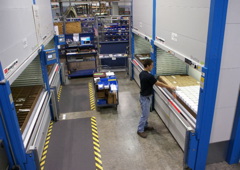Integrated Systems Design Aids Materials Handling
- Published: May 15, 2014
WIXOM, MI | Integrated Systems Design (ISD) is a manufacturer, systems consultant, designer, and integrator for order picking, packaging, shipping, and assembly operations for warehousing, manufacturing, distributing, and retailing organizations in North America.
Company says its solutions focus on providing space savings, increased productivity, reduced labor, higher accuracy, and system flexibility to change as an operation's activities change in the future. Reportedly, utilizing proven technology and off-the-shelf components helps provide cost-effective solutions requiring minimum maintenance and yielding fast ROI. 
Materials handling process improvement is said to be an effective way to meet lean and green initiatives, reduce operating costs, and provide a foundation for sustainable building design. Improving processes often translates into balancing zones better, reducing buffer storage, eliminating inventory and human touches by combining applications and areas. Consolidating operations, particularly non-value added operations such as storage, not only reduces inventory, but also recovers space for more valued-added functions. In some cases, entire buildings can be removed from operations. Automated storage and retrieval systems such as horizontal carousels are well suited to recovering space by facilitating consolidation of order picking operations. Horizontal carousels can be grouped and stacked and can be connected by conveyor systems for added throughput and efficiency in order picking operations.
Other examples include taking advantage of unused overhead space with the installation of automated storage and retrieval systems including: mini-loads, mid-loads, unit loads, shuttle technologies, vertical carousels, and Vertical Lift Modules (VLMs) reportedly can reclaim 60%–85% of the floor space used by traditional rack and shelving systems.
By reducing the amount of space required for operations, companies can construct smaller, more energy efficient buildings, shrinking the construction footprint by up to 15% in some cases, conserving natural resources and reducing maintenance costs. In existing buildings, consolidation and overhead space optimization help reduce energy costs, which in turn reduces an organization's overall carbon footprint.
Company also says it can help reduce the cost of labor, and the associated costs of health care and training, by modifying workflow routines to eliminate bottlenecks, redundant, or non-essential operations.
This email address is being protected from spambots. You need JavaScript enabled to view it.




